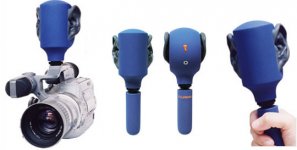It doesn't have to be hifi, just functional.QSound - Wikipedia@discopete: Not all CD's are the same, it would require a high SQ system to get the most of these kind of effects as far as I knew.
Yamaha once made 'elephant ear' drivers. Legend has it the elephant in between was rarely sighted
Last edited:
Friendly conversation here. Thought you might have some insight.Hi,
Why the devil would I even attempt to describe specifics of things I have not yet measured? I already said I won't entertain the thought of specific examples as they would be a massive waste of my time. Not unless you want to foot the bill for the lab time and setup.
Try and be reasonable and look at things that are of value. If you want to trot out specifics that you haven't even measured, you are wasting your time as well as everyone else's.
Thank you all. Some of the recording technique was explained to me previously, no mystery there. The mystery is in "how to interpret the readings" because we can not improve that particular experience without being able to quantify relevant measurement. Perhaps we still need to wait a bit more to gain a scientific method to do so, we still need to continue with the hit and miss brute force trial for the time being.
I know that too, but nobody has shown me what difference was measured between a recording that sounded holographic and one that is flat
College I went to had sketches by Paul McCartney describing exactly where in space he wanted the various instruments in his records placed.
This is done with the pan pot, volume and careful eq'ing and may be a touch of reverb during the mix stage after recording them.
Obviously this goes for close miked multitrack recording, if you record straight to stereo you get what you get.
Here's another. Usable on any system.BEDINI ELECTRONICS, INC..@discopete: Not all CD's are the same, it would require a high SQ system to get the most of these kind of effects as far as I knew.
Yamaha once made 'elephant ear' drivers. Legend has it the elephant in between was rarely sighted
I don't see it as a problem for the electronics, it's more of a speaker/room issue in that they don't impart their own spatial cues.Thank you all. Some of the recording technique was explained to me previously, no mystery there. The mystery is in "how to interpret the readings" because we can not improve that particular experience without being able to quantify relevant measurement. Perhaps we still need to wait a bit more to gain a scientific method to do so, we still need to continue with the hit and miss brute force trial for the time being.
How did Qsound or Bedini B.A.S.E come about without measurements? They didn't invent themselves.Thank you all. Some of the recording technique was explained to me previously, no mystery there. The mystery is in "how to interpret the readings" because we can not improve that particular experience without being able to quantify relevant measurement. Perhaps we still need to wait a bit more to gain a scientific method to do so, we still need to continue with the hit and miss brute force trial for the time being.
To Indra, In fact i don't see how you would 'improve' things. Either you have the illusion either you haven't it.
To 'improve' on it you'll start to modify the result hence you are not hi fidelity to the source. The only way the effect could be 'deeper' ( improved on) could come from an other layer of effect from loudspeaker/room interaction enhancing the feeling imho ( i suspect this is one of the appeal of dipole loudspeakers for classical music).
If you want a good measurement to determine this i would take a look at time domain analysis tools.
Step and impulse response should tell you a lot regarding the ability of a system to reproduce this clues ( the transients are VERY important).
To 'improve' on it you'll start to modify the result hence you are not hi fidelity to the source. The only way the effect could be 'deeper' ( improved on) could come from an other layer of effect from loudspeaker/room interaction enhancing the feeling imho ( i suspect this is one of the appeal of dipole loudspeakers for classical music).
If you want a good measurement to determine this i would take a look at time domain analysis tools.
Step and impulse response should tell you a lot regarding the ability of a system to reproduce this clues ( the transients are VERY important).
Last edited:
Hi Discopete,
No problem then.
I'd like to stay on track, and involving specific examples that may not represent the question tends to sidetrack things.
What I can say is that everything and anything that can be heard, any signal you can hear - can be measured. It's pretty amazing that we came this far in my lifetime. I have spent my life in audio service and design, so have always been involved with how things sound.
-Chris
No problem then.
I'd like to stay on track, and involving specific examples that may not represent the question tends to sidetrack things.
What I can say is that everything and anything that can be heard, any signal you can hear - can be measured. It's pretty amazing that we came this far in my lifetime. I have spent my life in audio service and design, so have always been involved with how things sound.
-Chris
Yes, and the end result is an acoustic output normal human can hear, therefore measurable.College I went to had sketches by Paul McCartney describing exactly where in space he wanted the various instruments in his records placed.
This is done with the pan pot, volume and careful eq'ing and may be a touch of reverb during the mix stage after recording them...
From syn08 response, I can guess that his million dollar measuring gears tells him something he is incapable to interpret, therefore the assessment (and probably exacerbated by the med he missed) tempted him to name the effect a BS and anybody who hears it a liar. Hopefully he is not correct in this particular case.
Remember Nelson Pass showed a negative phase H2 has an effect on depth illusion, but somewhat less on height.I don't see it as a problem for the electronics, it's more of a speaker/room issue in that they don't impart their own spatial cues.
Thank you. I'll look a bit more into it.... If you want a good measurement to determine this i would take a look at time domain analysis tools. Step and impulse response should tell you a lot regarding the ability of a system to reproduce this clues ( the transients are VERY important).

. He said that the SanDisk Clip+ already met the threshholds of human hearing, it's a $20 device from K-mart or Amazon, I already bought two of them, his claim that I need to provide evidence to the scientific community that the SanDisk Clip+ sounds different than the flagship DAC's from Analog Devices & TI is just.. evidence-myopia.
So basically you have no evidence? Why the rant then?
From syn08 response, I can guess that his million dollar measuring gears tells him something he is incapable to interpret, therefore the assessment (and probably exacerbated by the med he missed) tempted him to name the effect a BS and anybody who hears it a liar. Hopefully he is not correct in this particular case.
Syn08 is correct. Two speakers can place an image across a plane between left and right. Up and down and back to front are illusions created in the head that can be helped with careful EQ and phase shift. You never wondered how, with 2 ears you can tell if a sound is above you?
HRTF.
Binaural is nice. Blumlein are interesting in the way they recreate the image they capture too ( the inverted image on the 'back' of the couple make for some interesting effects when used wisely). I've seen Binaural (with Neumann dummy head) used with loudspeakers as source to bring 'naturalness' back to some close miced source material once played with L/R with diaphony. Pretty effective in this case.
Binaural is nice. Blumlein are interesting in the way they recreate the image they capture too ( the inverted image on the 'back' of the couple make for some interesting effects when used wisely). I've seen Binaural (with Neumann dummy head) used with loudspeakers as source to bring 'naturalness' back to some close miced source material once played with L/R with diaphony. Pretty effective in this case.
Last edited:
Now you call me a liar? I get that illusion nonetheless, whether it was a true location or not is irrelevant.
Since you made this admission, you are not a liar. Only yet another audiophile that enjoys his delusions.
Syn08 is correct. Two speakers can place an image across a plane between left and right.
Wouldn't be great if we could biangulate instead of triangulate? Imagine the savings in GPS satellites.
You posted this earlier, specifically giving the THD figures for the amps involved:...
- the 845 amp has much more distortion than the LM3886 amp
Yes, I have no doubt the measurements are "absolutely reliable" and you can get various audio labs to measure the THD of each amp and they'll all come close to the numbers you gave....
After several listening sessions all the partecipants did agree that with a 845 DHT SE amplifier the piano, the voices and especially the orchestra were reproduced much more realistic than using a LM3886 based amp.
The measurement told the opposite.
The LM3886 based amp has a THD around 0.002 % at 40W/8 ohm while the DHT based amp has a THD around 1% at 15W/8 om.
Therefore although the measurements are absolutely reliable they don't explain what we have heard.
Those of us with "enquiring minds" care - why not add some (bad, distorting) circuitry to the LM3886 amp so it also give 1 percent THD? Would it make it sound the same?So, does people like distortion?
Maybe, I don't know and mostly I don't care.
The problem is that THD is a gross (as in inaccurate and misleading) measure of an amplifier's perceived audio quality. Yes, this is in spite of every manufacturer publishing this figure, as well as many or most audiophile magazines likewise measuring THD of reviewed units and publishing their measurements. It could be called The Big Lie of audio. It's certainly one of them.
Here's a couple of threads discussing this (and an attempt to come up with a better metric, but that's not even my point here):
Geddes on Distortion perception
Basically through an ellaborate test of some 25 college students we were able to show that THD and IMD are meaningless measurements of distortion as far as perception is concerned. Basically one cannot say that something does or does not sound good based on these measurements. .01% can sound outrageous in some cases and 25% can be inaudible in others. The numbers are meaningless.
This post starts off with a bang:
The Gedlee Metric Demystified
Since the 1930's, measurement of Total Harmonic Distortion (THD) has been recognised as a poor arbiter of sound quality.
Differences between amplifiers and their sounds can be much better characterized and explained with other measurements (easily made in recent decades with modern computers - someone in this thread mentioned spectrum), but not with THD.
- Status
- Not open for further replies.
- Home
- Member Areas
- The Lounge
- Sound Quality Vs. Measurements

